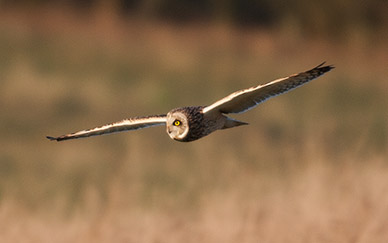Short-eared owl (Asio flammeus)
When: Mainly from September to April
How many: Very scarce

Short-eared owls typically occur in Hampshire from September until April, although breeding is occasionally recorded. Some of the winter-visiting short-eared owls are British breeders from northern upland areas, whilst others originate in Scandinavia, Russia and Iceland.
Numbers of short-eared owls in Hampshire vary annually, and peak when prey is abundant - short-tailed field voles are favourite food items, although other voles, mice and birds are also taken. Throughout their range, short-eared owls are similarly nomadic; wanderers that converge on vole-rich countryside in times of plenty, but are largely absent in times of famine.
Short-eared owls are, though, usually scarce in the New Forest, for here voles and other small rodents are rarely abundant - grazing by deer and commoners’ stock deprives them of the vegetation necessary for concealment. Indeed, Hampshire Bird Reports suggest concurrent presence of no more than three birds, although in recent years, at least two communal roosts have been found in gorse.
Short-eared owls are partly diurnal, and are the most likely day-flying owl to be seen in open countryside - what a treat it is to see one of these magnificent creatures quartering a favoured stretch of New Forest heath or bog in languid, stiff-winged hunting flight. Most often, though, short-eared owls emerge in mid- or late-afternoon, and continue hunting through the hours of darkness.
Short-eared owl plumage is pale yellow-brown and ochre-white, with heavy streaking. Conspicuously round faced, they are also noticeably small-headed. Black patches around strikingly yellow eyes are distinctive, and so are dark wing tips. The ear-tufts that give the bird its name are, however, small and rarely seen – they’re not ears at all, of course, but are simply tufts of feathers that are raised when the owl is agitated, afraid or simply curious.
Body length is not much more than that of a collared dove, yet the owl’s narrow, somewhat pointed wings are specifically designed for buoyant flight – they measure fully 1 metre (39 inches), which is twice that of those of the dove.
References:
Collins Bird Guide: Killian Mullarney, Lars Svensson, Dan Zetterstrom and Peter J.Grant
The Birds of the Western Palearctic, Concise Edition: D.W. Snow and C.M. Perrins
Birds of Hampshire: Hampshire Ornithological Society
Hampshire Bird Reports: Hampshire Ornithological Society
Raptors – A field guide to survey and monitoring: John Hardey, Humphrey Crick, Chris Wernham, Helen Riley, Brian Etheridge, Des Thompson
Owls of Europe: Heimo Mikkola
More links
Other related links
Search this site

Sadly, 58 animals were killed - 35 ponies, 13 cows, 8 donkeys and 2 sheep, whilst a further 32 were injured - 3 pigs, 9 donkeys, 11 cows and 9 ponies.
(Forty-three accidents occurred in daylight, 15 at twilight and 101 in the dark. Twenty-seven accidents were not reported by the driver involved).
Here's just one horrific example - Three donkeys killed in collision with van at notorious New Forest blackspot (Advertiser and Times)

